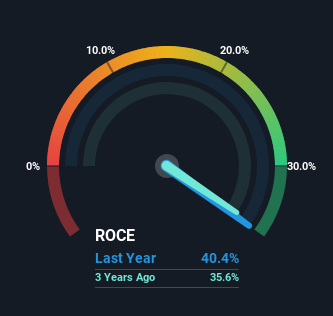- United Kingdom
- /
- IT
- /
- LSE:KNOS
Why You Should Care About Kainos Group's (LON:KNOS) Strong Returns On Capital
Did you know there are some financial metrics that can provide clues of a potential multi-bagger? In a perfect world, we'd like to see a company investing more capital into its business and ideally the returns earned from that capital are also increasing. If you see this, it typically means it's a company with a great business model and plenty of profitable reinvestment opportunities. That's why when we briefly looked at Kainos Group's (LON:KNOS) ROCE trend, we were very happy with what we saw.
What Is Return On Capital Employed (ROCE)?
For those that aren't sure what ROCE is, it measures the amount of pre-tax profits a company can generate from the capital employed in its business. The formula for this calculation on Kainos Group is:
Return on Capital Employed = Earnings Before Interest and Tax (EBIT) ÷ (Total Assets - Current Liabilities)
0.40 = UK£53m ÷ (UK£234m - UK£103m) (Based on the trailing twelve months to March 2023).
Thus, Kainos Group has an ROCE of 40%. That's a fantastic return and not only that, it outpaces the average of 9.9% earned by companies in a similar industry.
See our latest analysis for Kainos Group

In the above chart we have measured Kainos Group's prior ROCE against its prior performance, but the future is arguably more important. If you're interested, you can view the analysts predictions in our free report on analyst forecasts for the company.
What Can We Tell From Kainos Group's ROCE Trend?
In terms of Kainos Group's history of ROCE, it's quite impressive. The company has consistently earned 40% for the last five years, and the capital employed within the business has risen 263% in that time. With returns that high, it's great that the business can continually reinvest its money at such appealing rates of return. If these trends can continue, it wouldn't surprise us if the company became a multi-bagger.
Another thing to note, Kainos Group has a high ratio of current liabilities to total assets of 44%. This can bring about some risks because the company is basically operating with a rather large reliance on its suppliers or other sorts of short-term creditors. While it's not necessarily a bad thing, it can be beneficial if this ratio is lower.
The Key Takeaway
Kainos Group has demonstrated its proficiency by generating high returns on increasing amounts of capital employed, which we're thrilled about. And the stock has done incredibly well with a 206% return over the last five years, so long term investors are no doubt ecstatic with that result. So while the positive underlying trends may be accounted for by investors, we still think this stock is worth looking into further.
Before jumping to any conclusions though, we need to know what value we're getting for the current share price. That's where you can check out our FREE intrinsic value estimation that compares the share price and estimated value.
If you'd like to see other companies earning high returns, check out our free list of companies earning high returns with solid balance sheets here.
Valuation is complex, but we're here to simplify it.
Discover if Kainos Group might be undervalued or overvalued with our detailed analysis, featuring fair value estimates, potential risks, dividends, insider trades, and its financial condition.
Access Free AnalysisHave feedback on this article? Concerned about the content? Get in touch with us directly. Alternatively, email editorial-team (at) simplywallst.com.
This article by Simply Wall St is general in nature. We provide commentary based on historical data and analyst forecasts only using an unbiased methodology and our articles are not intended to be financial advice. It does not constitute a recommendation to buy or sell any stock, and does not take account of your objectives, or your financial situation. We aim to bring you long-term focused analysis driven by fundamental data. Note that our analysis may not factor in the latest price-sensitive company announcements or qualitative material. Simply Wall St has no position in any stocks mentioned.
About LSE:KNOS
Kainos Group
Engages in the provision of digital technology services in the United Kingdom, Ireland, the Americas, Central Europe, and internationally.
Flawless balance sheet with high growth potential.
Similar Companies
Market Insights
Community Narratives



